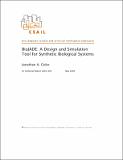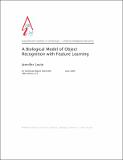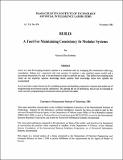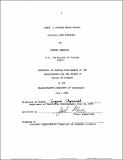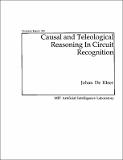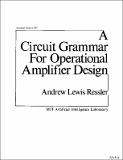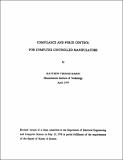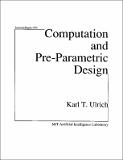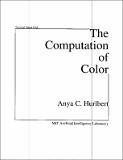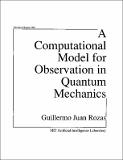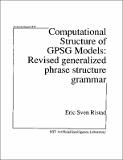Browsing AI Technical Reports (1964 - 2004) by Title
Now showing items 30-49 of 327
-
Basis Reduction Algorithms and Subset Sum Problems
(1991-06-01)This thesis investigates a new approach to lattice basis reduction suggested by M. Seysen. Seysen's algorithm attempts to globally reduce a lattice basis, whereas the Lenstra, Lenstra, Lovasz (LLL) family of reduction ... -
BioJADE: A Design and Simulation Tool for Synthetic Biological Systems
(2004-05-28)The next generations of both biological engineering and computer engineering demand that control be exerted at the molecular level. Creating, characterizing and controlling synthetic biological systems may provide us ... -
A Biological Model of Object Recognition with Feature Learning
(2003-06-01)Previous biological models of object recognition in cortex have been evaluated using idealized scenes and have hard-coded features, such as the HMAX model by Riesenhuber and Poggio [10]. Because HMAX uses the same set ... -
Boundaries and Topological Algorithms
(1988-09-01)This thesis develops a model for the topological structure of situations. In this model, the topological structure of space is altered by the presence or absence of boundaries, such as those at the edges of objects. ... -
BUILD: A Tool for Maintaining Consistency in Modular Systems
(1985-11-01)Build is a tool for keeping modular systems in a consistent state by managing the construction tasks (e.g. compilation, linking, etc.) associated with such systems. It employs a user supplied system model and a ... -
Building Grounded Abstractions for Artificial Intelligence Programming
(2004-06-16)Most Artificial Intelligence (AI) work can be characterized as either ``high-level'' (e.g., logical, symbolic) or ``low-level'' (e.g., connectionist networks, behavior-based robotics). Each approach suffers from particular ... -
CARPS: A Program which Solves Calculus Word Problems
(1968-07-01)A program was written to solve calculus word problems. The program, CARPS (CALculus Rate Problem Solver), is restricted to rate problems. The overall plan of the program is similar to Bobrow's STUDENT, the primary ... -
Causal and Teleological Reasoning in Circuit Recognition
(1979-09-01)This thesis presents a theory of human-like reasoning in the general domain of designed physical systems, and in particular, electronic circuits. One aspect of the theory, causal analysis, describes how the behavior ... -
A Circuit Grammar For Operational Amplifier Design
(1984-01-01)Electrical circuit designers seldom create really new topologies or use old ones in a novel way. Most designs are known combinations of common configurations tailored for the particular problem at hand. In this thesis ... -
Coherent Behavior from Incoherent Knowledge Sources in the Automatic Synthesis of Numerical Computer Programs
(1981-01-01)A fundamental problem in artificial intelligence is obtaining coherent behavior in rule-based problem solving systems. A good quantitative measure of coherence is time behavior; a system that never, in retrospect, ... -
A Colony Architecture for an Artificial Creature
(1989-09-01)This report describes a working autonomous mobile robot whose only goal is to collect and return empty soda cans. It operates in an unmodified office environment occupied by moving people. The robot is controlled by a ... -
Combining Associational and Causal Reasoning to Solve Interpretation and Planning Problems
(1988-08-01)This report describes a paradigm for combining associational and causal reasoning to achieve efficient and robust problem-solving behavior. The Generate, Test and Debug (GTD) paradigm generates initial hypotheses using ... -
Compact Representations for Fast Nonrigid Registration of Medical Images
(2003-07-04)We develop efficient techniques for the non-rigid registration of medical images by using representations that adapt to the anatomy found in such images. Images of anatomical structures typically have uniform intensity ... -
A Compilation Strategy for Numerical Programs Based on Partial Evaluation
(1989-02-01)This work demonstrates how partial evaluation can be put to practical use in the domain of high-performance numerical computation. I have developed a technique for performing partial evaluation by using placeholders ... -
Compliance and Force Control for Computer Controlled Manipulators
(1979-04-01)Compliant motion occurs when the manipulator position is constrained by the task geometry. Compliant motion may be produced either by a passive mechanical compliance built in to the manipulator, or by an active ... -
Computation and Pre-Parametric Design
(1988-09-01)My work is broadly concerned with the question "How can designs bessynthesized computationally?" The project deals primarily with mechanical devices and focuses on pre-parametric design: design at the level of detail ... -
The Computation of Color
(1989-09-01)This thesis takes an interdisciplinary approach to the study of color vision, focussing on the phenomenon of color constancy formulated as a computational problem. The primary contributions of the thesis are (1) the ... -
A Computational Model for Observation in Quantum Mechanics
(1987-03-01)A computational model of observation in quantum mechanics is presented. The model provides a clean and simple computational paradigm which can be used to illustrate and possibly explain some of the unintuitive and ... -
A Computational Model of Skill Acquisition
(1973-08-01)This thesis confronts the nature of the process of learning an intellectual skill, the ability to solve problems efficiently in a particular domain of discourse. The investigation is synthetic; a computational performance ... -
Computational Structure of GPSG Models: Revised Generalized Phrase Structure Grammar
(1989-09-01)The primary goal of this report is to demonstrate how considerations from computational complexity theory can inform grammatical theorizing. To this end, generalized phrase structure grammar (GPSG) linguistic theory ...


